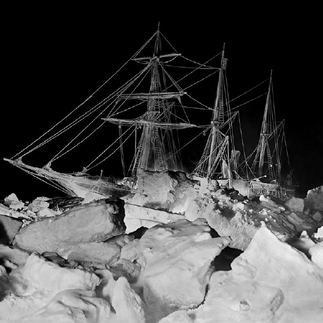Frank Hurley: From Antarctic Survival to the Front Lines – A Photographer’s Journey Through Extremes
Updated: Nov 14, 2024

Frank Hurley’s legacy as a pioneering photographer and adventurer is filled with tales of extreme environments, survival, and an enduring passion for capturing the world’s most remote landscapes. Born James Francis Hurley in October 1885 in Glebe, Sydney, Australia, Hurley’s journey from a rebellious teenager to a legendary photographer is remarkable. His father, Edward, was a Lancashire-born typesetter and trade unionist, while his mother, Margaret, came from a family of vintners in Alsace Lorraine. Together, they nurtured Hurley’s early interest in exploration and adventure.
At just 13, Hurley ran away from home to work as a steel fitter’s apprentice. Though he initially studied engineering, his true passion emerged when he saved enough to purchase a Kodak box camera, painstakingly paying it off in weekly instalments. His first assignments involved shooting images for postcards, a modest start that ignited his love for photography. Reflecting on this turning point, Hurley later said, “I knew I had found my real work.” Hurley’s talent and ambition quickly set him apart, and he began experimenting with photographic techniques that would later define his career.

Frank Hurley’s Early Antarctic Adventures with Douglas Mawson
In 1910, Hurley’s burgeoning career took a dramatic turn when he met Australian explorer Douglas Mawson, who invited him to document his 1911–1914 Antarctic expedition. Mawson’s journey through the desolate, ice-bound wilderness was perilous; two men perished, and Mawson barely survived a gruelling solo march back to base after missing the ship home. Hurley’s documentary of the expedition, Home of the Blizzard, featured some of the earliest moving footage of the Antarctic and turned him into a celebrated figure. The film’s success helped secure funding to rescue Mawson, marking Hurley’s first encounter with the life-threatening conditions of the polar regions and earning him a reputation for his resilience.
The Endurance Arctic Expedition: Frank Hurley Joins Shackleton
In 1914, Sir Ernest Shackleton, the seasoned polar explorer, invited Hurley to join the Endurance expedition, one of the most famous survival stories in the history of exploration. Shackleton’s goal was to make a daring 1,800-mile coast-to-coast trek across the largely uncharted Antarctic continent. The pair met in Buenos Aires, and their connection was immediate. “Shackleton was an explorer of the type who carried the Union Jack over uncharted seas and planted it in the heart of unknown lands for sheer adventure’s sake,” Hurley would later write.
However, the expedition’s course changed drastically when Endurance became trapped in the ice of the Weddell Sea in 1915. After months of pressure from the shifting ice, the ship was eventually crushed, leaving Hurley and 27 others stranded. As the men drifted on an ice floe at the mercy of the elements, Hurley’s skills went beyond photography; he proved himself an invaluable team member.
Using his engineering background, Hurley crafted a makeshift blubber stove from an oil drum to help them survive in the frozen wilderness. He also showed a pragmatic side, hunting and eventually eating the sledge dogs when food supplies became critically low.
“Hunger brings us all to the level of other species,”

Hurley’s Photography Techniques: Capturing the Spirit of Antarctica
Hurley’s images from the Endurance expedition are among the most iconic in Antarctic exploration. Using glass plates and large-format cameras, Hurley captured haunting images of the frozen landscape, the beleaguered ship, and his crewmates braving the icy conditions. His tools included about seven cameras and two cine cameras, alongside an array of lenses and both black-and-white and experimental colour films. Hurley was known for his daring techniques, often incorporating flash photography and experimenting with colour filters to bring out the stark contrasts in the icy Antarctic light. He also controversially created photo montages, layering images to evoke the grandeur and isolation of the Antarctic, breaking convention in a way that some critics described as “pictorial artistry.”
The weight of Hurley’s glass plates became a contentious issue as the crew prepared for a gruelling journey over the ice. Shackleton deemed them too cumbersome to carry, and Hurley faced a painful decision. In a sombre moment on the ice, Hurley sifted through his 600 glass plates, carefully selecting only 150 of his best images and shattering the rest, ensuring he wouldn’t second-guess his choices. These images became iconic, offering some of the most vivid glimpses into the frozen landscape of Antarctica and the lives of those who braved its extremes.

Frank Hurley’s Struggle to Save His Photographic Plates
Perhaps Hurley’s most harrowing act of devotion to his craft came when the Endurance was finally abandoned. With the ship sinking under the crushing ice, Hurley stripped off his clothes and plunged naked into the freezing waters to retrieve his photographic plates. His effort preserved a small portion of the visual history he had captured, ensuring that his documentation of the Antarctic would not disappear with the doomed vessel.
When Shackleton and a select few embarked on a hazardous journey to seek help, Hurley and the rest of the crew were left stranded on Elephant Island for over four months, enduring the bitter cold and scarce rations. Shackleton eventually returned with rescue in August 1916. Hurley’s photographs survived the ordeal, becoming a powerful testament to the endurance and courage of Shackleton’s men.
Hurley’s Later Adventures and Wartime Photography
After his return from the harrowing Antarctic expeditions, Frank Hurley’s career took a significant turn as he applied his photographic skills to a new arena: the Western Front during World War I. In 1917, Hurley was sent to document the Australian troops fighting in one of the bloodiest conflicts of the war, capturing the brutal and unforgiving conditions of Passchendaele in Belgium. The front lines presented a new kind of challenge, vastly different from the frozen landscapes of the Antarctic. Yet Hurley brought the same dedication, resilience, and artistic vision to capturing the horrors and human elements of warfare that he had shown in polar exploration.
Hurley’s approach to wartime photography was groundbreaking and controversial. Conditions on the Western Front were unforgiving, with incessant mud, shell-blasted landscapes, and the constant threat of enemy fire. Hurley quickly realised that traditional photographic methods couldn’t fully convey the scale of the destruction and intensity of trench warfare. To address this, he developed his distinctive style of composite photography, combining multiple negatives to create sweeping panoramic images of the battlefield. This technique allowed Hurley to portray the chaos and devastation of war in a way that went beyond simple documentation, bringing a visual depth and dynamism to his images that was rare for the time. His composite images, however, faced resistance from military officials and purists who argued that they compromised the authenticity of war photography. Yet Hurley defended his approach, famously stating that “to include the mass of uninteresting material which surrounds an interesting incident would not do justice to the event.”
Hurley’s images from the Western Front show stark contrasts between the camaraderie of soldiers and the pervasive desolation surrounding them. He captured intimate moments shared between men, quiet scenes of soldiers resting or sharing a laugh, juxtaposed with haunting images of destroyed landscapes, blasted trees, and endless mud. Hurley’s work during this period included photographs of soldiers trudging through shell holes filled with water, ruined towns and villages, and the aftermath of battles. His eye for composition and his determination to portray both the heroism and the suffering of soldiers set his work apart and elevated his images from simple records to powerful statements on the nature of modern warfare.
In the midst of this intense work, Hurley found a semblance of stability in his personal life. During his time at the Western Front, he married Antoinette, marking the beginning of a lifelong partnership. His letters and journals from this period reveal his desire for connection amid the chaos and his commitment to capturing history as he witnessed it.
Hurley’s wartime photography didn’t end with World War I. His reputation as a war photographer grew, and he continued to document conflicts throughout his career. During World War II, even in his mid-50s, Hurley joined Australian forces again, this time travelling to North Africa and the Middle East. His images from this period show a matured style and an unflinching approach to the realities of warfare, capturing scenes from battles at El Alamein and other major sites.
The 1920s saw Hurley travelling across the globe, capturing images of people, landscapes, and wildlife from exotic locations. He returned to Antarctica with Mawson in 1929, solidifying his status as one of the most experienced polar photographers of his era. Back in Australia, Hurley filmed the construction of the Sydney Harbour Bridge in the early 1930s and was later commissioned to make a film celebrating the 150th anniversary of Australia’s founding. His career encompassed over 50 films, and in 1941, he was awarded the OBE in recognition of his contributions to photography and filmmaking. A man of indefatigable spirit, he was still on assignment the day before he passed away on 16 January 1962 at age 76.
Sources
Shackleton's Forgotten Men: The Untold Tragedy of the Endurance Epic (2001) – Available on Penguin Books:https://www.penguin.com.au/books/shackletons-forgotten-men-9781845951751
Argonauts of the South (1925) – Available on Archive.org:https://archive.org/details/in.ernet.dli.2015.22739/page/n5/mode/2up
The Home of the Blizzard: A True Story of Antarctic Survival (1915) – Available on Archive.org:https://archive.org/details/homeofblizzardbe00maws
Frank Hurley: A Photographer's Life (2004) – Available on Penguin Books Australia:https://www.penguin.com.au/books/frank-hurley-a-photographers-life-9780857982449
Frank Hurley - National Film and Sound Archive of Australia:https://www.nfsa.gov.au/collection/curated/frank-hurley
South: The Story of Shackleton’s 1914-1917 Expedition (1919) – Available on Archive.org:https://archive.org/details/southstoryofshac00shacuoft
Frank Hurley: Wartime Photographer - Australian War Memorial:https://www.awm.gov.au/articles/encyclopedia/frank_hurley
Frank Hurley's Antarctica (2011) – Available on Australian Geographic:https://www.australiangeographic.com.au/product/frank-hurleys-antarctica/































































































